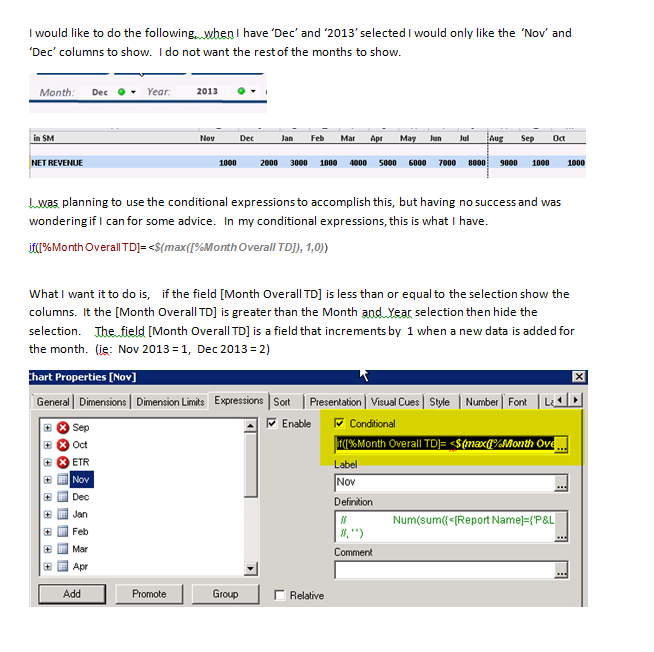Unlock a world of possibilities! Login now and discover the exclusive benefits awaiting you.
- Qlik Community
- :
- All Forums
- :
- QlikView App Dev
- :
- conditional expressions (hide/show)
- Subscribe to RSS Feed
- Mark Topic as New
- Mark Topic as Read
- Float this Topic for Current User
- Bookmark
- Subscribe
- Mute
- Printer Friendly Page
- Mark as New
- Bookmark
- Subscribe
- Mute
- Subscribe to RSS Feed
- Permalink
- Report Inappropriate Content
conditional expressions (hide/show)

- « Previous Replies
-
- 1
- 2
- Next Replies »
- Mark as New
- Bookmark
- Subscribe
- Mute
- Subscribe to RSS Feed
- Permalink
- Report Inappropriate Content
May be try this:
Only({<1>} [% Month Overall TD]) <= Max([% Month Overall TD])
- Mark as New
- Bookmark
- Subscribe
- Mute
- Subscribe to RSS Feed
- Permalink
- Report Inappropriate Content
or this:
Only({<1>} [% Month Overall TD]) = Max([% Month Overall TD]) or Only({<1>} [% Month Overall TD]) = (Max([% Month Overall TD]) - 1)
- Mark as New
- Bookmark
- Subscribe
- Mute
- Subscribe to RSS Feed
- Permalink
- Report Inappropriate Content
thank you for your quick responses Sunny T. I've tried all your suggestions and they don't work.
- Mark as New
- Bookmark
- Subscribe
- Mute
- Subscribe to RSS Feed
- Permalink
- Report Inappropriate Content
Sorry, I had a typo, can you try this:
Only({1} [% Month Overall TD]) <= Max([% Month Overall TD])
- Mark as New
- Bookmark
- Subscribe
- Mute
- Subscribe to RSS Feed
- Permalink
- Report Inappropriate Content
I just put in your new expression ' =Only({1} [%Month Overall TD]) <= Max([%Month Overall TD]) 'into a text box for testing purposes, and it is not evaluating it because it has an '-'. However, when I use this expression '=Only({<1>} [%Month Overall TD]) = Max([%Month Overall TD]) ', it is evaluating it as a '-1'.
- Mark as New
- Bookmark
- Subscribe
- Mute
- Subscribe to RSS Feed
- Permalink
- Report Inappropriate Content
I know what the problem is. You need to provide set analysis condition here:
Only({1<[% Month Overall TD] = {1}>} [% Month Overall TD]) <= Max([% Month Overall TD])
Replace 1 with whatever the value of Month is for the particular expression
- Mark as New
- Bookmark
- Subscribe
- Mute
- Subscribe to RSS Feed
- Permalink
- Report Inappropriate Content
the field [%Month Overall TD] is a numeric value. For Nov 2013 it would be '1', however, for Nov 2014 it would be '13'. I apologize, but when you say replace the 1 with whatever the value of the Month, it would be different for every year because it would be 1 in Nov2013, but 13 in Nov2014.
- Mark as New
- Bookmark
- Subscribe
- Mute
- Subscribe to RSS Feed
- Permalink
- Report Inappropriate Content
How about this:
Nov would show up for when Nov is selected and Dec is selected, right? Assuming Nov-2013 is a 1 and Nov-2014 is a 13, try this for Nov expression:
Nov
Mod([% Month Overall TD], 12) = 1 or Mod([% Month Overall TD], 12) = 2
Dec
Mod([% Month Overall TD], 12) = 2 or Mod([% Month Overall TD], 12) = 3
...
- Mark as New
- Bookmark
- Subscribe
- Mute
- Subscribe to RSS Feed
- Permalink
- Report Inappropriate Content
Hi Sunny:
I think we are getting close to the solution. It looks like it work for Nov, Dec, and Jan when it is selected. However, when I select Feb, only Nov, Jan, and Feb shows. If I select Mar, only Nov, Feb, and Mar shows.
To be precise, when Nov-2013 is selected the %Month Overall TD is 61 and when Nov-2014 is selected it is 73, a change in 12(12 months).
Trung
- « Previous Replies
-
- 1
- 2
- Next Replies »